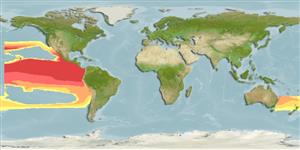Environment: milieu / climate zone / depth range / distribution range
Ökologie
seewasser; ozeanodrom (Ref. 51243); tiefenbereich 0 - ? m. Subtropical
Eastern Pacific: southern California, USA to Panama, including the Galapagos Islands; rare in northern Baja California, Mexico. Range extends to Ecuador (Ref. 36576).
Size / Gewicht / Alter
Maturity: Lm ? range ? - ? cm
Max length : 48.0 cm TL Männchen/unbestimmt; (Ref. 2850); common length : 35.0 cm TL Männchen/unbestimmt; (Ref. 9306); max. veröff. Gewicht: 223.25 g (Ref. 124487)
Rückenflossenstacheln (insgesamt): 0; Rückenflossenweichstrahlen (insgesamt): 12-15; Afterflossenstacheln 0; Afterflossenweichstrahlen: 11 - 13; Wirbelzahl: 54 - 58. Body elongate; lower jaw very prolonged; upper jaw short, triangular, and without scales; lower branch of first gill arch with 26 to 32 gill rakers; fins lacking spines; pectoral fins long; caudal fin deeply forked, the lower lobe longer than the upper; anal fin with 10 to 13 rays; back dark blue; flanks and belly silvery white; edge of lower jaw red; upper lobe of caudal fin violet blue, its tip red (Ref. 55763). Branchiostegal rays: 13-15 (Ref. 36576).
An oceanic species which occurs near surface. Adults form very big schools (Ref. 9306). Feed on small fishes and planktonic organisms (Ref. 9306). Oviparous, with planktonic larvae (Ref. 36576). Eggs are attached to floating objects via filaments (Ref. 36576). Found in markets of Panama (Ref. 9306).
Life cycle and mating behavior
Geschlechtsreife | Fortpflanzung | Ablaichen | Eier | Fecundity | Larven
Eschmeyer, W.N., E.S. Herald and H. Hammann, 1983. A field guide to Pacific coast fishes of North America. Boston (MA, USA): Houghton Mifflin Company. xii+336 p. (Ref. 2850)
IUCN Rote Liste Status (Ref. 130435)
Bedrohung für Menschen
Harmless
Nutzung durch Menschen
Fischereien: kommerziell; Köder: occasionally
Mehr Information
ReferenzenAquakulturAquakultur ProfilZuchtlinienGenetikElectrophoresesVererbbarkeitKrankheitenVerarbeitungNutrientsMass conversion
PartnerBilderStamps, Coins Misc.LauteCiguateraGeschwindigkeitSchwimmstilKiemenoberflächeOtolithsGehirngrößeSehfähigkeit
Tools
Zusatzinformationen
Download XML
Internet Quellen
Estimates based on models
Preferred temperature (Ref.
123201): 15.2 - 26.4, mean 19.7 °C (based on 68 cells).
Phylogenetic diversity index (Ref.
82804): PD
50 = 0.5005 [Uniqueness, from 0.5 = low to 2.0 = high].
Bayesian length-weight: a=0.00398 (0.00220 - 0.00719), b=2.97 (2.82 - 3.12), in cm total length, based on LWR estimates for this species & Genus-body shape (Ref.
93245).
Trophic level (Ref.
69278): 4.0 ±0.65 se; based on food items.
Widerstandsfähigkeit (Ref.
120179): hoch, Verdopplung der Population dauert weniger als 15 Monate. (Preliminary K or Fecundity.).
Fishing Vulnerability (Ref.
59153): Moderate vulnerability (38 of 100).
